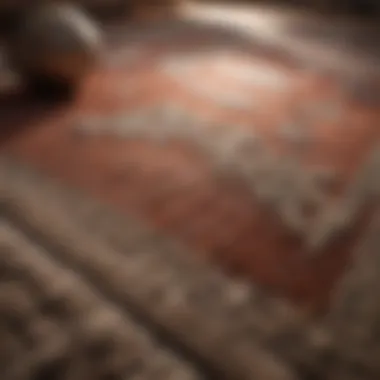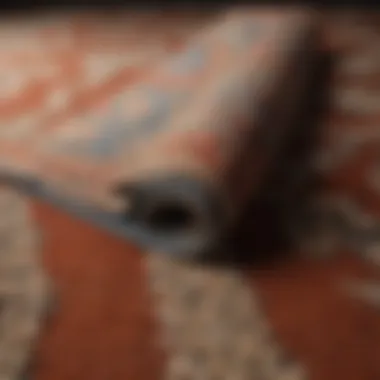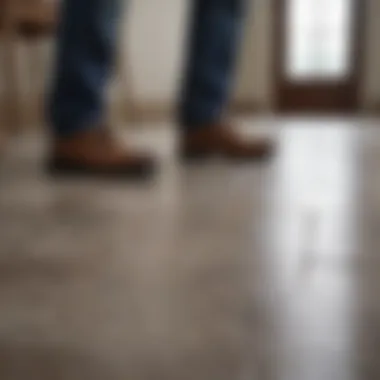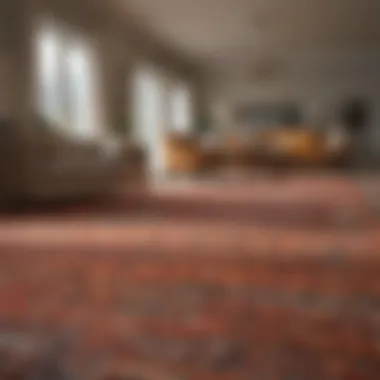Understanding Carpet Installation Costs Per Square Foot


Intro
When it comes to selecting the right flooring, carpet remains a classic choice for many homeowners. Its appeal lies in its comfort, insulation, and aesthetic versatility. However, understanding the cost per square foot for carpet and pad installation is critical for budgeting any home improvement project.
This article aims to unravel the complexities surrounding pricing, focusing on various elements like materials, labor, and geographic differences. Grasping these cost components is essential for making informed flooring decisions.
Key Insights and Trends
Understanding the cost associated with carpet and pad installation involves not just the numbers, but also the trends shaping the interior design landscape today.
Current Trends in Interior Design
More homeowners are gravitating towards sustainable and eco-friendly materials. Innovations in carpeting technologies have produced options that are both durable and environmentally-friendly. Brands are increasingly offering recycled materials and natural fibers that appeal to eco-conscious consumers.
From texture to color, the choices have expanded. Some popular color schemes include muted tones and rich jewel colors that can invigorate any space. Designed carpets featuring unique patterns are also gaining traction, breaking the monotony often seen in traditional flooring.
"Choosing the right carpet not only affects cost but also the visual harmony of your home."
Popular Carpet Materials
Choosing the right material influences the cost greatly. Common materials include:
- Nylon: Known for its resilience, often favored for high-traffic areas.
- Polyester: Offers a softer feel, but less durability, generally lower cost.
- Olefin: Resistant to moisture and fading, ideal for outdoor spaces.
- Wool: A natural option that provides excellent insulation, but often the priciest.
Evaluating Total Costs
To fully grasp the cost per square foot for carpet installation, it's imperative to break down the total expense into comprehensible components:
Components of Cost
- Material Costs: This covers both the carpet and pad. Different materials yield varying price ranges.
- Labor Costs: Skilled installers demand fair compensation. Labor charges can range widely based on location and expertise.
- Additional Fees: Consider possible fees for removal of old flooring or moving furniture.
Regional Variances
Prices are also influenced by geographic differences. Urban areas might command higher labor costs due to increased demand and cost of living. In contrast, rural regions may have lower prices, albeit with fewer options for specialized materials. This discrepancy is crucial for homeowners to consider when planning their budgets.
Practical Considerations
Understanding the costs is one thing, but making informed choices is crucial.
Tips for Homeowners
- Get Multiple Quotes: Always consult various installers to gauge an accurate market rate.
- Calculate Your Needs: Measure your space precisely. It prevents overspending on excess materials.
- Evaluate Long-Term Benefits: Sometimes higher upfront costs for premium materials can pay off in longevity and less maintenance.
By delving into these various elements, homeowners and renters can navigate the complexities of carpet and pad installation with greater clarity and confidence. This preparation sets the foundation for successful and beautiful flooring projects.
Preface to Carpet Installation Costs
Understanding the costs associated with carpet installation is crucial for homeowners and renters alike. The carpet serves as both a functional element and an aesthetic feature within a space. Knowing the cost per square foot can greatly influence decision-making when it comes to flooring choices.
When discussing installation costs, several factors come into play. These can include the type of carpet selected, the quality of padding, and the complexity of the installation process itself. Understanding these elements not only helps in budgeting effectively but also in choosing the right products that match individual preferences and needs.
Being informed about carpet installation costs empowers property owners to weigh options carefully. Whether one is seeking a durable carpet for high traffic areas or something more luxurious for a living room, the associated costs form the foundation of any flooring project. It is recommended that consumers conduct thorough research and gather multiple quotes from contractors to facilitate informed decisions.
Moreover, different regions might present distinct pricing, thereby necessitating statistical insight into local markets. Layering in knowledge about installation costs protects against unexpected increases and fosters a more seamless renovation experience.
Overview of Carpet as a Flooring Option


Carpet continues to be a popular choice among consumers due to its comfort, warmth, and sound-absorbing qualities. It is available in a variety of styles, colors, and textures, which makes it versatile for many design schemes. From plush to Berber, the options provide flexibility in achieving the desired look of a room.
In addition to its aesthetic appeal, carpet also serves practical purposes. It can enhance safety by reducing slips and falls, especially in homes with children and elderly residents. Furthermore, carpets can contribute to energy efficiency by providing insulation.
However, it is essential to recognize that carpet requires maintenance. Regular cleaning is necessary to prevent dust and allergens from accumulating, and certain materials may be more difficult to clean than others. Hence, before selecting carpet as a flooring option, consumers should consider both aesthetic and functional factors.
The Importance of Understanding Cost per Square Foot
Understanding the cost per square foot is essential because it lays the foundation for determining the overall investment in a flooring project. The cost factors include material prices, labor fees, and possible additional charges related to furniture moving or subfloor preparation.
By having a clear picture of cost implications, homeowners can prioritize their needs and budget accordingly. For instance:
- Quality of Carpet: Higher-quality carpets may exhibit better durability and appearance, meriting their cost.
- Installation Fees: Depending on the complexity, labor costs can increase the overall price.
- Region: Prices fluctuate based on local market conditions, so it's vital to research regional variances.
An informed understanding helps homeowners to prevent unexpected expenses. This knowledge aids in exploring various options that align best with their budgets and aesthetic desires, ultimately leading to more fulfilling flooring choices.
Factors Influencing Carpet Pricing
Understanding the costs associated with carpet installation is crucial for anyone considering new flooring. The total price per square foot can vary significantly based on several key factors. This section examines the most significant elements that influence carpet pricing. By grasping these variables, homeowners and renters can make informed decisions that align with their budgets and preferences.
Material Types and Quality
The type and quality of carpet material play a pivotal role in pricing. Carpets are available in various fibers, each with its own price point and characteristics. Common options include nylon, polyester, and wool. Nylon is known for its durability and resilience, making it a popular choice for high-traffic areas. It often comes at a higher price due to its longevity. Polyester, while usually cheaper, offers stain resistance but may not hold up as well over time.
Wool is often considered the premium option. Its natural qualities make it luxurious, but this often translates to higher costs. Furthermore, the weight and density of the carpet affect pricing. Thicker carpets are generally more expensive, but they may offer better comfort and sound absorption. Overall, the choice of material is fundamental in determining the final cost per square foot.
Padding Options and Their Impact
Padding serves as a crucial component of carpet installation. It provides comfort, insulation, and sound absorption. The type of padding chosen can significantly influence the overall cost. Various materials are available, including foam, rubber, and fiber padding. Generally, rubber padding tends to be more expensive but offers superior durability and pleasant underfoot feel.
Foam padding is often the most affordable and provides decent comfort, yet it may compress over time. Fiber padding is eco-friendly but can be less durable compared to its counterparts. The thickness of the padding also matters; thicker padding enhances comfort but increases the overall installation cost. Choosing the right padding is essential, as it not only affects immediate comfort but also extends the life of the carpet.
Labor Costs and Installation Complexity
Labor costs can vary based on location, the complexity of the installation, and the expertise of the installers. Typically, professional installation is recommended to ensure a perfect fit and finish. Complex installations require more time and skill, leading to increased labor costs. For instance, stairs or intricate layouts require additional effort and therefore cost more.
The average installation cost can be calculated as a percentage of the material cost. It is not uncommon for labor to account for about 20% or more of the total project cost. Hiring experienced professionals may lead to a higher upfront expense, but it can result in better longevity for the carpet and less risk of mistakes during installation.
Regional Variations in Pricing
Geographic location has a considerable influence on carpet prices. Urban centers often have higher costs due to higher demand and elevated overhead expenses for suppliers and contractors. In contrast, rural areas may offer lower prices, but options may be more limited. Understanding regional variances is vital for accurate budgeting.
Additionally, prices can be affected by regional market trends, availability of materials, and the number of skilled laborers in the area. Being aware of these variances can help consumers identify the best deals and make educated choices regarding their carpet purchases.
"Understanding the factors influencing carpet pricing leads to better decision-making and ensures that buyers receive the best value for their investment."
In summary, various considerations influence the cost per square foot for carpet and pad installation. By assessing material types and quality, padding options, labor costs, and regional pricing variations, consumers can make informed decisions that align with their budget and aesthetic preferences. This foundational understanding sets the stage for practical calculations in subsequent sections.
Calculating the Total Cost for Carpet Installation
Calculating the total cost for carpet installation is a critical aspect of the flooring decision-making process. Understanding how to accurately assess these costs is essential for homeowners to avoid unexpected expenditures. It allows for informed budgeting and planning, ensuring that the selection of materials and services aligns with one's financial parameters. Key components, including precise measurements of the space, material pricing, and the inclusion of labor fees, can significantly influence the overall investment. This section will dissect these elements in detail, offering clear insights into the considerations necessary when calculating the total cost.
Measuring Your Space Accurately


Accurate measurement of the area where the carpet will be installed is paramount. Improper measurements can lead to purchasing either too much or too little carpet, both of which can inflate costs unnecessarily. Using a simple measuring tape will suffice, but a laser measure can enhance precision.
Follow these steps for effective space measurement:
- Clear the Area: Remove any furniture to ensure you can measure unobstructed surfaces.
- Measure Length and Width: Measure each room's length and width, writing down the dimensions.
- Calculate Square Footage: Multiply length by width to determine the square footage of the space. If the room has irregular shapes, break it into smaller squares or rectangles, calculate separately, and then sum.
- Consider Waste Factor: Add about 10% to account for mistakes, seams, or irregular cuts. This ensures that the carpet will fit snugly and look good once installed.
By following these steps, you can achieve a clearer understanding of the size you are working with and avoid extra costs from miscalculations.
Estimating Material Costs
Once the space is measured accurately, the next step is estimating the costs of materials, specifically the carpet and padding. Understanding that different materials come at varying price points is crucial. Quality carpeting options may have higher initial costs but could provide greater longevity and satisfaction over time.
Important factors to consider:
- Carpet Types: From plush to berber, each carpet type has different pricing depending on the fibers used, such as nylon, polyester, or wool.
- Padding Choices: The type of padding used beneath the carpet impacts comfort and durability. Higher-quality pads can enhance the carpet's lifespan but also add to the overall cost.
- Grade of Material: Different grades can result in stark variations in price. Higher grades often indicate better quality and longer-lasting products, impacting the total expenditure.
Researching various materials through local suppliers and websites will help in making informed decisions regarding carpet choices and their associated costs.
Including Labor and Additional Fees
Labor costs represent a significant portion of the total installation expense. The complexities involved in installing carpet can vary based on the layout of the space, the presence of stairs, or any intricate cuts required.
Here are several considerations:
- Local Rates: Labor rates can differ based on geographic location. Familiarizing yourself with local market rates can guide expectations.
- Installation Methods: Certain installation methods, such as stretched installations or glue-down methods, can have varying labor costs.
- Additional Fees: Be aware of potential additional fees, such as moving furniture or removing old flooring. Account for these in the total budget.
Understanding and incorporating labor costs and other fees into your overall budget will sharpen your approach, leading to a more accurate total cost.
"Accurate calculations not only save money but also avoid the frustration of unmet expectations."
Common Misconceptions About Carpet Costs
Quality vs. Price
One prevalent misconception in the realm of carpet installation revolves around the relationship between quality and price. Many individuals assume that a higher-priced carpet automatically signifies superior quality. However, this notion is simplistic and often misleading. Different brands offer distinct manufacturing processes and utilize various materials, impacting both durability and comfort levels.
While premium carpets made from natural fibers like wool can provide an exquisite aesthetic and feel, they often come with a significant price tag. Conversely, carpets made from synthetic materials can also deliver great performance at a lower cost. Therefore, it's crucial to evaluate the specific performance attributes and not merely the price point. Understanding your personal preferences and lifestyle needs plays a pivotal role in making the best choice.
In this context, thorough research should inform decisions and not just reliance on perceived value dictated by price alone.
Long-Term Cost Considerations
The long-term cost considerations of carpet installation is another area prone to misunderstanding. Many homeowners tend to focus solely on the upfront cost, neglecting the ongoing expenses associated with maintaining their carpets.
Investing in a quality carpet may involve a higher initial expenditure but can lead to savings over time. A durable carpet typically requires less frequent replacement and can endure wear from foot traffic better than cheaper alternatives. Thus, selecting a carpet with higher durability can turn out to be more economical in the long run.
Moreover, maintenance practices, such as regular cleaning and prompt treatment of stains, impact the lifespan of a carpet significantly. Ignoring carpet care can lead to increased wear and subsequent costs for replacements or repairs. Therefore, it's wise to consider both the initial investment and total cost of ownership when choosing carpet.
Key takeaway: Assessing carpet costs involves looking beyond the sticker price to understand long-term implications to make an informed investment.
Maximizing the Value of Your Investment
Maximizing the value of your investment is essential when it comes to carpet and pad installation. This process involves not only selecting the right materials but also ensuring that these options meet your specific needs and conditions. It’s not just about the initial cost per square foot but also about the long-term advantages that come with making informed choices. Understanding material types, proper installation, and maintenance can greatly extend the lifespan and look of your carpet, ultimately safeguarding your financial commitment.


Choosing the Right Carpet Type for Your Needs
Selecting the appropriate carpet type is vital in maximizing your investment. Different carpets offer varying levels of durability, softness, and maintenance requirements. Consider factors like foot traffic, room function, and personal style when making your decision. Some popular types include:
- Nylon: Known for its resilience, nylon is ideal for high-traffic areas. It resists wear and tear effectively.
- Polyester: Although softer and more affordable, polyester may not be as durable as nylon. It's better for low-traffic spaces.
- Wool: A luxurious option, wool comes with a higher price tag but provides excellent durability and a natural feel.
Understanding the pros and cons of each type can help you choose one that aligns with your needs and lifestyle.
Maintenance Practices to Extend Longevity
Proper maintenance practices play a crucial role in extending the life of your carpet. Regular upkeep will not only preserve its aesthetic but also prevent premature wear. Here are effective maintenance tips:
- Regular Vacuuming: Frequent vacuuming helps to remove dirt and debris, which can degrade carpet fibers over time.
- Professional Cleaning: Schedule professional cleaning at least once every 12 to 18 months. This can refresh your carpet and remove deeper stains.
- Spot Treatment: Addressing spills immediately can prevent staining. Use appropriate cleaning solutions specific to your carpet type.
- Furniture Placement: Rotate furniture occasionally and use furniture coasters. This prevents uneven wear on the carpet surface.
- Avoid Excessive Moisture: Too much moisture can lead to mold growth. Use carpet protectors or ensure good ventilation in humid areas.
"Investing in high-quality carpets and maintaining them diligently is key to achieving long-term value."
Sustainable Considerations in Carpet Selection
Sustainability has become a pivotal concern for homeowners and designers alike. Understanding sustainable considerations in carpet selection is essential for making thoughtful choices that contribute positively to the environment. Eco-friendly carpets not only reduce the ecological footprint but also often enhance indoor air quality. By choosing sustainable options, homeowners can ensure their living spaces are healthy and environmentally responsible.
Incorporating sustainable materials into flooring choices tackles not just the aesthetic aspects, but also the practical benefits. Consumers are now more aware of how their selections affect the planet. This trend motivates manufacturers to innovate, creating materials that are both durable and less harmful to the environment. Opting for sustainable carpets can also yield long-term cost savings and improved comfort without compromising style.
Eco-Friendly Material Options
There are several eco-friendly material options for carpets that merit consideration. One prominent choice is recycled polyester, derived from discarded plastic bottles. This material not only diverts waste from landfills but also offers stain resistance and vibrant color options. Another option is wool, which is a natural fiber known for durability and biodegradability.
Additionally, nylon made from renewable sources is increasingly popular. It combines sustainability with great performance and longevity.
Consider the following points when exploring eco-friendly materials:
- Natural Fibers: Choose materials like jute or sisal, which are biodegradable and produced sustainably.
- Low-VOC Options: Look for carpets indicating low volatile organic compounds, which lead to improved indoor air quality after installation.
- Certifications: Certifications like the Cradle to Cradle and Green Label Plus indicate that the products adhere to stringent environmental standards.
Impact of Carpet Disposal and Recycling
The disposal of carpets can pose serious environmental issues if not handled properly. When carpets are discarded, they often end up in landfills, contributing significantly to waste. However, recycling programs can mitigate this issue. Many manufacturers offer take-back programs that allow homeowners to return old carpet for recycling.
Proper disposal methods for carpets include:
- Recyclability: Not all carpets can be recycled. Some can be turned into new flooring or other products, while others may only serve as fuel in waste-to-energy plants.
- Donation: If the carpet is still in good condition, consider donating it to organizations or community projects. This practice extends the life of the carpet and provides benefit to others.
- Responsible Disposal: Check local guidelines for disposing of flooring materials. Knowing your options will help minimize the environmental repercussions.
To make a informed decision, consider both procurement and disposal practices when you select carpet flooring.
The End
In this article, we have delved into the comprehensive factors that contribute to the cost per square foot for carpet and padding installation. Understanding these elements is crucial for anyone considering new flooring options. Each aspect, from the materials used to the labor involved, offers insight into how costs accumulate and how to make wise financial decisions.
Recap of Key Insights
- Material Variations: The type of carpet significantly influences the overall spend. Choosing between nylon, polyester, or wool can alter both the aesthetic and durability of your flooring.
- Padding Choice: The padding selected plays an essential role in comfort and longevity. While cheaper padding might initially seem appealing, it may affect the carpet’s lifespan and performance over time.
- Labor Costs: These can vary widely, depending on local market rates and the complexity of the installation. Hiring experienced professionals typically ensures better results but may come at a higher price.
- Regional Differences: Being aware of local pricing can help in budget planning. Costs in urban areas tend to be higher due to increased demand and operational expenses.
This synthesis clarifies that a careful evaluation of these factors can lead to a more informed purchase and satisfaction with the final result.
Final Thoughts on Making Informed Decisions
When it comes to installing carpet, knowledge is power. Each decision—from the material choice to the installation process—has ramifications that impact both immediate costs and long-term value. Homeowners and renters alike should prioritize education and seek multiple quotes to ensure they obtain the best price for the desired quality. Informed consumers are less likely to fall prey to upselling tactics, allowing them to prioritize their actual flooring needs over flashy recommendations.
Ultimately, making informed decisions means considering both current trends and personal lifestyle needs. This ensures the carpet will meet functional expectations and align with personal taste, creating a space that is both inviting and practical.
"Investing in quality and understanding your flooring options will reward you in comfort and aesthetic appeal over years of use."
In closing, this guide serves as a foundation for evaluating the cost per square foot in carpet and pad installation. As the market continues to evolve, staying informed will enable you to navigate your flooring project with expertise.



